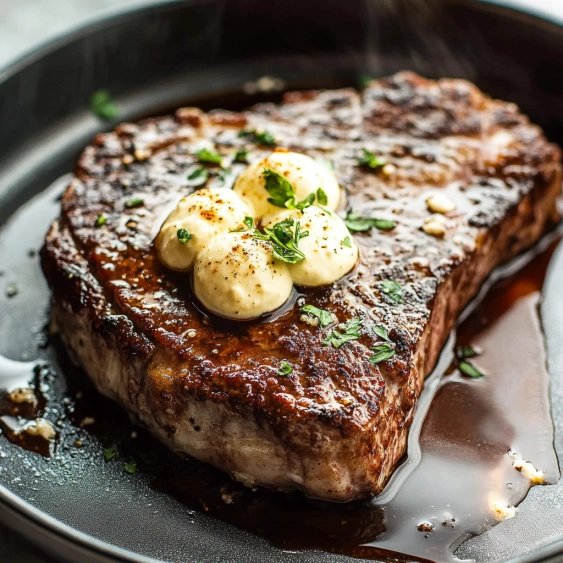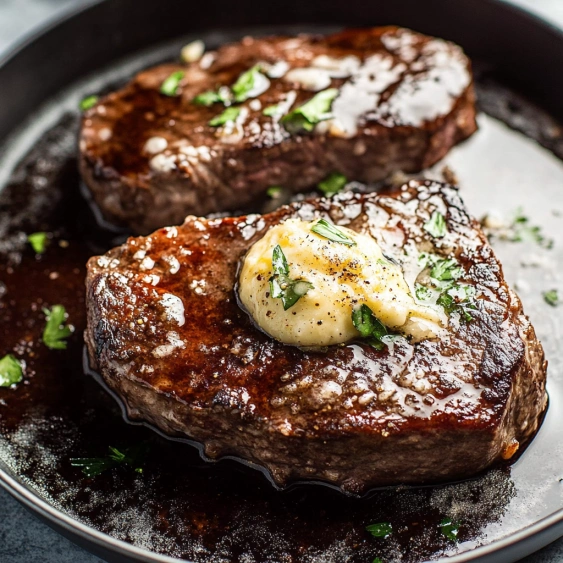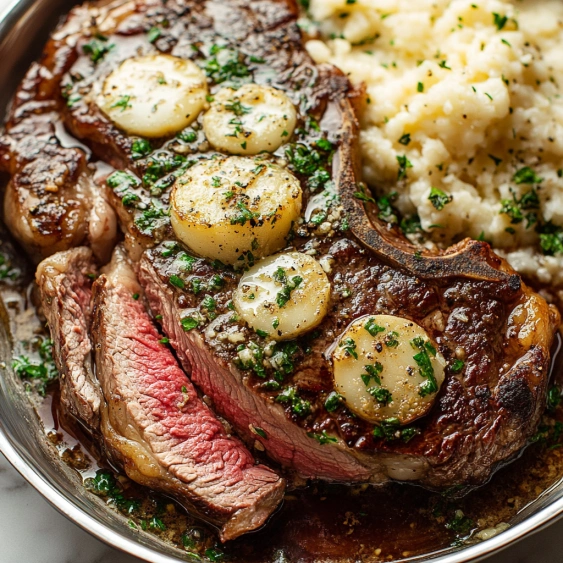 Pin it
Pin it
This ribeye steak recipe transforms an ordinary dinner into a restaurant-quality experience with minimal effort. The method delivers that perfect crust outside while maintaining a juicy, tender center that melts in your mouth.
I developed this method after years of disappointment with tough, overcooked steaks. Once I discovered the power of room temperature meat and a properly preheated cast iron skillet, my family started requesting steak nights weekly.
Ingredients
- Ribeye steaks: 1.25" thick chosen for their excellent marbling which creates natural flavor and tenderness
- Salt and pepper: applied generously as the perfect simple seasoning that enhances rather than masks beef flavor
- Olive oil: helps create an even cooking surface and prevents sticking in the initial sear
- Butter: divided into pats adds richness and creates a beautiful basting effect during the final minutes of cooking
- Cowboy butter (optional): highly recommended for an extra layer of flavor complexity
Step-by-Step Instructions
- Room Temperature Preparation:
- Take steaks out of refrigeration 30-60 minutes before cooking to ensure even cooking throughout. Cold steaks placed in a hot pan will result in overdone exteriors and underdone centers.
- Proper Drying and Seasoning:
- Pat steaks thoroughly dry with paper towels to remove surface moisture which is crucial for developing a proper sear. Season generously with salt and pepper on both sides allowing the seasoning to adhere to the meat.
- Preheating the Skillet:
- Heat a heavy cast iron skillet over medium-high to high heat until extremely hot approximately 3-5 minutes. The pan should be hot enough that a water droplet sizzles and dances across the surface immediately. Add olive oil and swirl to coat the cooking surface.
- First Side Sear:
- Place steaks carefully in the hot pan allowing them to cook completely undisturbed for 4 minutes. Moving them too early disrupts the crucial crust formation. You should hear an aggressive sizzle throughout this process.
- Flip and Butter Addition:
- Using tongs flip each steak once and immediately place butter pats on top of the hot steaks. The butter will begin to melt creating a flavorful basting liquid. Cook undisturbed for another 4 minutes for medium-rare doneness.
- Resting Period:
- Transfer steaks to a plate or cutting board and allow them to rest uncovered for 5-10 minutes. This critical step allows juices to redistribute throughout the meat instead of running out when cut.
 Pin it
Pin it
The butter finish is my favorite part of this technique. I discovered it accidentally when trying to replicate a steakhouse experience at home. The way it combines with the meat juices creates a natural sauce that my husband now insists on having with every steak dinner.
Understanding Steak Doneness
Cooking times vary based on your preferred doneness. For reference medium-rare registers 125°F-130°F internal temperature before resting and will rise 5-10 degrees during rest. Rare requires about 1 minute less per side while medium needs 1 minute more. Remember that a slightly undercooked steak can always cook more but an overcooked steak cannot be saved.
Perfect Pairing Suggestions
Ribeye steaks shine when paired with simple sides that complement without competing. Consider roasted garlic mashed potatoes which soak up the buttery steak juices beautifully. A bright arugula salad with lemon vinaigrette provides welcome acidity against the rich meat. For wine enthusiasts a bold Cabernet Sauvignon or Malbec enhances the beef's robust flavors through complementary tannins.
 Pin it
Pin it
Choosing Quality Ribeye
The starting quality of your ribeye dramatically affects the final result. Look for steaks with abundant marbling tiny flecks of white fat throughout the red meat. Choose steaks at least 1.25 inches thick which allows for proper searing while maintaining a juicy center. If possible select dry-aged ribeyes which offer concentrated flavor and tenderness though they command a premium price. Grass-fed beef provides different flavor notes than grain-finished with many preferring the latter for ribeye.
Frequently Asked Questions
- → How do I know when my steak is done?
The most accurate way is using an instant-read thermometer. For medium-rare ribeye (recommended), aim for 125°F-130°F before resting, as temperature will rise 5-10 degrees during rest. Medium is 135°F-145°F, while medium-well is 145°F-155°F. You can also use the touch test - medium-rare feels like pressing the base of your thumb when touching your middle finger.
- → Why should I bring steaks to room temperature?
Letting steaks sit at room temperature for 30-60 minutes ensures even cooking. Cold steaks placed in a hot pan will cook unevenly, with potentially overcooked exteriors and undercooked centers. Room temperature steaks cook more predictably and develop better caramelization.
- → What is cowboy butter?
Cowboy butter is a compound butter typically made with herbs, garlic, lemon, and spices. It melts beautifully over hot steaks, adding richness and complementary flavors. You can make it ahead and keep it refrigerated, slicing off medallions as needed for steaks and other dishes.
- → Can I use a different pan instead of cast iron?
While cast iron is ideal because it retains heat exceptionally well and creates the best sear, you can use any heavy-bottomed, oven-safe pan. Stainless steel works well, though you may need to adjust cooking time slightly. Avoid non-stick pans as they shouldn't be heated to the extremely high temperatures needed for proper steak searing.
- → Why is resting steak so important?
Resting allows the juices to redistribute throughout the meat. When steak cooks, the muscle fibers contract and push juices toward the center. If cut immediately, these juices spill onto the plate rather than remaining in the meat. A 5-10 minute rest ensures your steak stays moist and tender when served.
- → What does 'slicing against the grain' mean?
Meat has muscle fibers that run in a single direction (the 'grain'). Cutting perpendicular to these fibers (against the grain) shortens them, making each bite more tender and easier to chew. For ribeye, identify the direction of the muscle fibers and cut at a 90-degree angle to them for the most tender eating experience.
